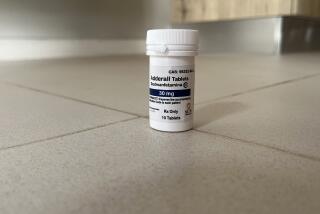Supply of AIDS Drug May Fall Short of Needs
- Share via
WASHINGTON — AZT, the only drug thus far shown to be effective in treating AIDS, is expected to be in short supply for a time after it becomes commercially available in early 1987--a prospect that raises fears there will not be enough for every patient who needs it, The Times has learned.
Officials at Burroughs Wellcome, the drug’s manufacturer, acknowledged Tuesday that they are worried and working around the clock to head off the shortage, which could prove critical in some cases because AIDS patients typically survive no longer than two years.
“The problem we have is a time-dependent one--we’re trying to do several years’ work in a couple of months,” said Dr. David Barry, the company’s vice president for research. “We’ve been immensely successful, but I wish we were six months ahead of where we are now. There will be periods of time when there won’t be enough drug for every patient who needs it.”
He added: “We’re running extremely fast and catching up, but the disease had a tremendous lead on us.”
AZT, or azidothymidine, is the first medication that has prolonged the lives of AIDS patients. Although it is not considered a cure, the early results of a nationwide study of 282 cases were so encouraging that an independent board of scientists decided in September that medical ethics required ending the study and giving the drug to additional AIDS patients. Since then, about 3,000 AIDS patients have been enrolled in the enlarged AZT program.
The Food and Drug Administration, which regulates new drugs, said at the time that it would accelerate the approval process for all promising AIDS drugs, and that AZT could be licensed as early as January.
Stepped-up Production
Burroughs Wellcome has increased AZT supplies tenfold every six months for the last 18 months, but the accelerated production still will not make enough of the drug until much later in the year, Barry said. The manufacturing of AZT requires at least 16 steps and takes several months, he said. Originally, AZT was derived from the sperm of fish, but the company has since developed methods of producing it synthetically.
“Less than two years ago, we were dealing with amounts in the fraction of an ounce. Now we’re processing between one and five tons of material a month,” he said.
Still, he said, “it’s the enormity of the volume we have to deal with--both in terms of raw materials and other aspects of development. If, 18 months ago, you had to cook for five people, and that increased tenfold every six months . . . and six months from now it’s 50,000, you can’t just go out and buy a few extra pots and pans. You have to set up new infrastructure, a new manufacturing plan.”
According to Public Health Service sources, another immediate problem is that of obtaining AZT for federally sponsored AIDS Treatment Evaluation Units, which are directed by the National Institute of Allergy and Infectious Diseases. The institute has already begun two AZT studies and is eager to do more.
Maker ‘Under Pressure’
“The institute is not able to get a lot of its protocols (studies) under way, because it needs both drug and the company’s technical involvement--but the company is under tremendous pressure to get its data together for licensure of the drug,” said one federal health official who requested anonymity.
“They have been working day and night to do that, but there’s an immediate short-term problem in supply for clinical studies that need to be done. It’s not a criticism of Burroughs Wellcome--they are trying very, very hard--but NIAID has also gotten caught up in the company’s supply and time problems and is being criticized for it.”
Barry said that Burroughs Wellcome has had “a close association” with NIAID in planning “for sufficient drug for the studies they have in mind” and that “once everyone is in agreement on what should be done, there won’t be any trouble getting enough drug to the centers who need it.”
Information for Doctors
Barry said the company also intends to run an education campaign for physicians, to prevent AZT from being prescribed inappropriately once it is on the market. Thus far, AZT has been available only to AIDS patients suffering from pneumocystis carinii pneumonia, a respiratory infection caused by a parasite, although other studies either planned or under way will use AZT to treat patients with other manifestations of AIDS.
“We want to be sure that patients who might benefit less from AZT don’t get it at the expense of those who might benefit more,” Barry said.
AIDS, or acquired immune deficiency syndrome, is caused by a virus that destroys the body’s immune system and leaves it powerless against certain cancers and otherwise rare infections. As of Monday, 29,003 cases of AIDS had been reported in the United States, of which 16,301 had ended in death.






